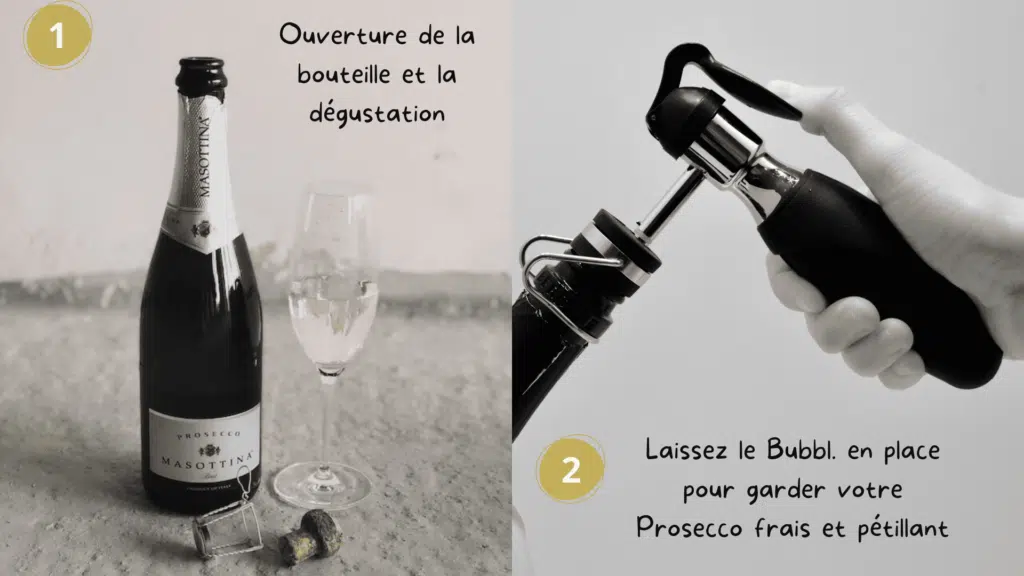Prosecco
Prosecco: a renowned Italian sparkling wine, perfectly preserved with Bubbl.
What is Prosecco wine?
Prosecco, originating from the picturesque Italian region of Veneto, is a sparkling wine that has taken the world by storm with its fruity freshness and lively effervescence. Its Dry and DOC appellations are often consumed as an aperitif. It is a delicate wine which, once opened, requires special attention to maintain its sparkling character and distinct aromas.
Bubbl., our innovative sparkling wine preservation system, is obviously perfectly suited to preserving these bubbles. Whether you’re enjoying a bottle of Prosecco during an intimate meal or serving a toast at a large event, Bubbl. is the ideal tool to ensure that each poured glass is as sparkling and flavorful as the first.
Prosecco: A wine with a rich history
This frizzante wine takes its name from the main grape variety used in its production – Glera. Although the production method differs from that of Champagne and Franciacorta, it produces an equally popular sparkling wine. The effervescence of Prosecco is obtained thanks to the Charmat process, where the second fermentation takes place in stainless steel vats, thus preserving the fresh fruity and floral aromas of the wine.
Preserving Prosecco with Bubbl.
Bubbl. proves to be a valuable ally for the conservation of Prosecco. Once Prosecco is opened, the wine begins to slowly lose its gas and delicate aromas. This is where the Bubbl system comes into play.
The “Smart Cap” ensures a perfect seal. The gas injected using the gun is an ideal mixture of CO2 (80%) and Nitrogen (20%): Bubbl. compresses the existing gas in the bottle, and thus prolongs the sparkling for up to a week while preserving the aromas. Every sip of your wine will be as fresh and flavorful as if the bottle had just been opened.
For lovers of this champagne who wish to enjoy their bottle over several days without compromising quality, Bubbl. is the essential tool to guarantee optimal wine tasting, every time.
Experience Prosecco at its best – fresh, sparkling and rich in aroma – with the help of Bubbl. Whether as an aperitif, Spritz, or dry, a world of flavors awaits those who choose to savor at their own pace.
FAQs:
Which Prosecco to replace champagne?
Si vous recherchez une alternative abordable et de qualité, ce vin pétillant est un excellent choix. Cependant, tous les Proseccos ne sont pas créés de la même manière. Pour une expérience qui se rapproche le plus possible de celle du champagne, voici quelques-uns à considérer :
- Prosecco Superiore DOCG: Prosecco Superiore DOCG is produced in the Conegliano and Valdobbiadene regions, north of Venice. The wines of this appellation are subject to strict production standards and are generally very beautiful wines. Look specifically for a Prosecco Superiore “Brut”, which has a sugar level comparable to many champagnes.
- Prosecco Cartizze: This is a small area within the Prosecco Superiore DOCG appellation. Wines from this region are generally richer and more complex than those from other Prosecco regions.
- Prosecco Col Fondo: This is a style fermented a second time in the bottle, just like champagne. This gives Prosecco Col Fondo a complexity and structure that can rival it.
What does Prosecco taste like?
It is generally more fruity and floral than most champagnes. It is famous for its bright, refreshing flavor which makes it a popular choice for appetizers and cocktails.
The primary aromas of Prosecco are often white-fleshed fruits like apple, pear, white citrus, and floral notes of white flowers like acacia and linden. Some sweeter Proseccos may also have notes of tropical fruit, melon and honey.
This champagne often has medium to high acidity and a slightly creamy mouthfeel. The sugar level can vary depending on the style, ranging from brut (very dry) to semi-dry (sweeter).
It is important to note that there is significant variety within the appellation. Proseccos from the Conegliano-Valdobbiadene DOCG region are generally better, with greater complexity and finer bubbles than Proseccos from the larger DOC region.
Overall, it is appreciated for its accessible flavor profile, its lightness and its ability to pair well with a variety of dishes.
How do you drink Prosecco?
It is an Italian sparkling wine that is generally drunk chilled. Here are some tips on how to best enjoy it:
- Temperature: Prosecco should be served well chilled, generally between 6 and 8 degrees Celsius. To achieve this temperature, place the bottle of Prosecco in the refrigerator or wine cellar for a few hours before serving. If you’re in a hurry, you can also place the bottle in a bucket filled with ice and water for about 30 minutes.
- Glass: Prosecco is usually served in a tulip glass or white wine glass. These types of glasses allow the Prosecco to retain its bubbles longer and highlight its delicate aromas.
- Tasting: When tasting Prosecco, take the time to note its color, effervescence, aroma and taste. Prosecco often has fruity and floral notes, with refreshing acidity and pleasant sweetness.
- Food and wine pairings: It can be served as an aperitif, as a Spritz or as a dry drink but it also goes well with various dishes. It is traditionally associated with antipasto and seafood, but it can also accompany light dishes such as salads, cream pastas and chicken.
- Cocktails: Prosecco is also often used in cocktails, such as the Bellini or the Aperol Spritz.
Remember, the most important rule is to enjoy Prosecco in the way you like most!
What is the difference between Prosecco and Cava?
Prosecco and Cava are two popular types of frizzante wines, but they are produced in different regions, from different grape varieties, and using different production processes. Here are some of the main differences between these two types of wine:
- Origin and grape varieties: Prosecco is produced in Italy, mainly in the Veneto and Friuli Venezia Giulia regions, from the Glera grape variety. Cava is produced in Spain, mainly in Catalonia, from indigenous grape varieties such as Macabeo, Parellada and Xarel·lo.
- Production method: Prosecco is generally produced using the Charmat method (or Italian method), in which the second fermentation (which produces the bubbles) takes place in stainless steel tanks. Cava is produced using the traditional method (also called the champenoise method), which is the same as that used for Champagne. There, the second fermentation takes place directly in the container.
- Taste Profile: Prosecco generally has a fresh, fruity taste profile, with notes of white-fleshed fruit, flowers and sometimes honey. Cava, due to the fermentation process in the bottle, often has notes of toast or brioche, in addition to fruity notes. It generally has higher acidity.
- Price: In general, both can vary in price, but Prosecco tends to be slightly cheaper than Cava, especially when comparing entry-level bottles.
- Bubbles: Prosecco generally has lighter, less persistent bubbles than Cava, which is known for its fine, persistent foam.
It is important to note that Prosecco and Cava can both vary greatly in quality and style, depending on many factors such as producer, vintage, and aging time on the lees.



